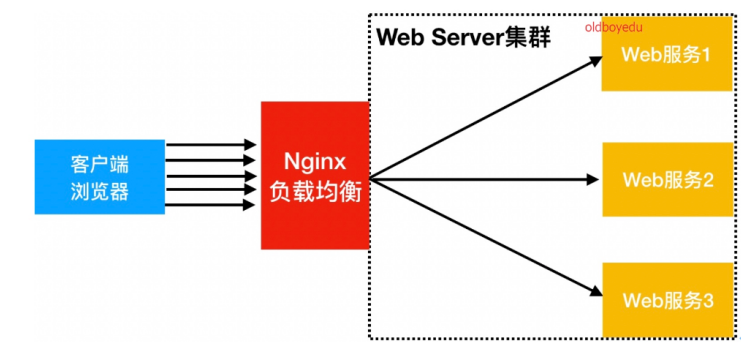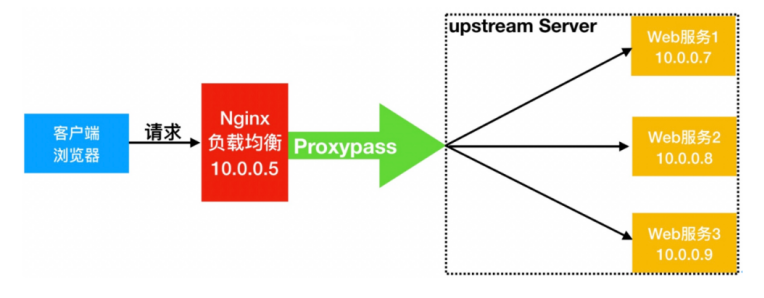Nginx七层负载均衡
第五章·Nginx七层负载均衡
Nginx负载均衡基本概述
为什么要使用负载均衡:
当我们的Web服务器直接面向用户,往往要承载大量并发请求,单台服务器难以负荷,我使用多台Web服务器组成集群,前端使用Nginx负载均衡,将请求分散的打到我们的后端服务器集群中,实现负载的分发。那么会大大提升系统的吞吐率、请求性能、高容灾

往往我们接触的最多的是SLB(Server Load Balance)负载均衡,实现最多的也是SLB、那么SLB它的调度节点和服务节点通常是在一个地域里面。那么它在这个小的逻辑地域里面决定了他对部分服务的实时性、响应性是非常好的。
所以说当海量用户请求过来以后,它同样是请求调度节点,调度节点将用户的请求转发给后端对应的服务节点,服务节点处理完请求后在转发给调度节点,调度节点最后响应给用户节点。这样也能实现一个均衡的作用,那么Nginx则是一个典型的SLB
负载均衡的叫法:
- 负载
- Load Balance
- LB
公有云中的叫法
- 阿里云:SLB
- 腾讯云:CLB
- 青云:QLB
- Ucloud:ULB
负载均衡产品
- 软件
- nginx
- HAproxy
- LVS
- 硬件
- F5
四层负载均衡和七层负载均衡的区别
四层负载:
所谓四层负载均衡指的是OSI七层模型中的传输层,那么传输层Nginx已经能支持TCP/IP的控制,所以只需要对客户端的请求进行TCP/IP协议的包转发就可以实现负载均衡,那么它的好处是性能非常快、只需要底层进行应用处理,而不需要进行一些复杂的逻辑
七层负载:
七层负载均衡它是在应用层,那么它可以完成很多应用方面的协议请求,比如我们说的http应用的负载均衡,它可以实现http信息的改写、头信息的改写、安全应用规则控制、URL匹配规则控制、以及转发、rewrite等等的规则,所以在应用层的服务里面,我们可以做的内容就更多,那么Nginx则是一个典型的七层负载均衡SLB
区别:
四层负载均衡数据包在底层就进行了分发,而七层负载均衡数据包则是在最顶层进行分发、由此可以看出,七层负载均衡效率没有四负载均衡高。
但七层负载均衡更贴近于服务,如:http协议就是七层协议,我们可以用Nginx可以作会话保持,URL路径规则匹配、head头改写等等,这些是四层负载均衡无法实现的。
注意:四层负载均衡不识别域名,七层负载均衡识别域名
Nginx负载均衡配置场景
Nginx要实现负载均衡需要用到 proxy_pass 代理模块配置.
Nginx负载均衡与Nginx代理不同地方在于,Nginx的一个 location 仅能代理一台服务器,而Nginx负载均衡则是 将客户端请求代理转发至一组upstream虚拟服务池.

负载均衡配置语法
Syntax: upstream name { ... }
Default: —
Context: http
upstream name {
server xxx;
server xxx;
}
官方案例配置
Syntax: upstream name { ... }
Default: -
Context: http
#upstream模块配置
模块名 后端主机池:名字(根据网站域名来起名)
upstream backend {
server backend1.example.com weight=5;
server backend2.example.com:8080;
server unix:/tmp/backend3;
server backup1.example.com:8080 backup;
}
server {
location / {
proxy_pass http://backend;
}
}
1.环境准备
| 角色 | 外网****IP(NAT) | 内网****IP(LAN) | 主机名 | 应用 |
|---|---|---|---|---|
| 负载均衡 | eth0:10.0.0.5 | eth1:172.16.1.5 | lb01 | nginx |
| web网站 | eth0:10.0.0.7 | eth1:172.16.1.7 | web01 | nginx、php |
| web网站 | eth0:10.0.0.8 | eth1:172.16.1.8 | web02 | nginx、php |
2.web01服务器上配置nginx
[root@web01 ~]# vim /etc/nginx/conf.d/lb.lw.com.conf
server {
listen 9999;
server_name lb.lw.com;
root /code/lb;
index index.html;
}
[root@web01 conf.d]# mkdir /code/lb
[root@web01 conf.d]# echo "web01" > /code/lb/index.html
root@web01 conf.d]# nginx -t
nginx: the configuration file /etc/nginx/nginx.conf syntax is ok
nginx: configuration file /etc/nginx/nginx.conf test is successful
[root@web01 conf.d]# systemctl reload nginx
3.web02服务器上配置nginx
[root@web02 ~]# vim /etc/nginx/conf.d/lb.lw.com.conf
server {
listen 9999;
server_name lb.lw.com;
root /code/lb;
index index.html;
}
[root@web02 conf.d]# mkdir /code/lb
[root@web02 conf.d]# echo "web01" > /code/lb/index.html
root@web02 conf.d]# nginx -t
nginx: the configuration file /etc/nginx/nginx.conf syntax is ok
nginx: configuration file /etc/nginx/nginx.conf test is successful
[root@web02 conf.d]# systemctl reload nginx
4.域名解析
## 域名解析
10.0.0.7 lb.lw.com
#10.0.0.8 lb.lw.com
5.准备Nginx负载均衡调度使用的proxy_params
[root@Nginx ~]# vim /etc/nginx/proxy_params
proxy_set_header Host $http_host;
proxy_set_header X-Real-IP $remote_addr;
proxy_set_header X-Forwarded-For $proxy_add_x_forwarded_for;
proxy_connect_timeout 30;
proxy_send_timeout 60;
proxy_read_timeout 60;
proxy_buffering on;
proxy_buffer_size 32k;
proxy_buffers 4 128k;
6.配置Nginx负载均衡
[root@lb01 ~]# vim /etc/nginx/conf.d/lb.lw.com.conf
upstream lb.lw.com {
server 172.16.1.7:9999;
server 172.16.1.8:9999;
}
server {
listen 80;
server_name lb.lw.com;
location / {
proxy_pass http://lb.lw.com;
include proxy_params;
}
}
[root@lb01 conf.d]# systemctl restart nginx
负载均衡常见典型故障
如果后台服务连接超时,Nginx是本身是有机制的,如果出现一个节点down掉的时候,Nginx会更据你具体负载均衡的设置,将请求转移到其他的节点上,但是,如果后台服务连接没有down掉,但是返回错误异常码了如:504、502、500,这个时候你需要加一个负载均衡的设置,如下:proxy_next_upstream http_500 | http_502 | http_503 | http_504 |http_404;意思是,当其中一台返回错误码404,500...等错误时,可以分配到下一台服务器程序继续处理,提高平台访问成功率
## 解决方案
### 遇到如下状态码的机器,跳过请求的下发,直接下发到其他正常的服务器
proxy_next_upstream error timeout http_500 http_502 http_503 http_504;
upstream lb.lw.com {
server 172.16.1.7:9999;
server 172.16.1.8:9999;
server 172.16.1.9:9999;
}
server {
listen 80;
server_name lb.lw.com;
location /{
proxy_pass http://lb.lw.com;
proxy_next_upstream error timeout http_500 http_502 http_503 http_504;
include proxy_params;
}
}
负载均衡调度算法
| 调度算法 | 概述 |
|---|---|
| 轮询 | 按时间顺序逐一分配到不同的后端服务器(默认) |
| weight | 加权轮询,weight值越大,分配到的访问几率越高 |
| ip_hash | 每个请求按访问IP的hash结果分配,这样来自同一IP的固定访问一个后端服务器 |
| url_hash | 按照访问URL的hash结果来分配请求,是每个URL定向到同一个后端服务器 |
| least_conn | 最少链接数,那个机器链接数少就分发 |
Nginx负载均衡[rr]轮询具体配置
upstream load_pass {
server 10.0.0.7:80;
server 10.0.0.8:80;
}
Nginx负载均衡[wrr]权重轮询具体配置
upstream load_pass {
server 10.0.0.7:80 weight=5;
server 10.0.0.8:80;
}
Nginx负载均衡ip_hash
具体配置不能和weight一起使用。
#如果客户端都走相同代理, 会导致某一台服务器连接过多
upstream load_pass {
ip_hash;
server 10.0.0.7:80 weight=5;
server 10.0.0.8:80;
}
Nginx负载均衡后端状态
| 状态 | 概述 |
|---|---|
| down | 当前的server暂时不参与负载均衡 |
| backup | 预留的备份服务器 |
| max_fails | 允许请求失败的次数 |
| fail_timeout | 经过max_fails失败后, 服务暂停时间 |
| max_conns | 限制最大的接收连接数 |
1.down 状态:只是负载均衡不对该标识的服务器下发请求,后端的服务器并没有真正宕机
upstream lb.lw.com {
server 172.16.1.7:9999;
server 172.16.1.8:9999 down;
server 172.16.1.9:9999;
}
server {
listen 80;
server_name lb.lw.com;
location /{
proxy_pass http://lb.lw.com;
include proxy_params;
}
}
2.backup 状态:备份,当前其它没有backup标识机器都宕机时,才会给该服务器发请求
upstream lb.lw.com {
server 172.16.1.7:9999;
server 172.16.1.8:9999 backup;
server 172.16.1.9:9999;
}
server {
listen 80;
server_name lb.lw.com;
location /{
proxy_pass http://lb.lw.com;
include proxy_params;
}
}
max_fails:负载均衡访问后端,最大错误次数,到该指定次数后,不给该服务器发送请求
fail_timeout:配合max_fails使用,规定不发请求的时间段
upstream lb.lw.com {
server 172.16.1.7:9999 max_fails=3 fail_timeout=10s;
server 172.16.1.8:9999 max_fails=3 fail_timeout=10s;
server 172.16.1.9:9999 max_fails=3 fail_timeout=10s;
}
server {
listen 80;
server_name lb.lw.com;
location /{
proxy_pass http://lb.lw.com;
include proxy_params;
}
}
4.max_conn:限制该后端web服务器最大连接数为1024个
upstream lb.lw.com {
server 172.16.1.7:9999 max_fails=3 fail_timeout=10s;
server 172.16.1.8:9999 max_fails=3 fail_timeout=10s;
server 172.16.1.9:9999 max_fails=3 fail_timeout=10s max_conn=1024;
}
server {
listen 80;
server_name lb.lw.com;
location /{
proxy_pass http://lb.lw.com;
include proxy_params;
}
}
Nginx负载均衡健康检查
在Nginx官方模块提供的模块中,没有对负载均衡后端节点的健康检查模块,但可以使用第三方模块。
nginx_upstream_check_module来检测后端服务的健康状态。
第三方模块项目地址:TP
1.安装依赖包
[root@lb01 ~]# yum install -y gcc glibc gcc-c++ pcre-devel openssl-devel patch
2.停掉yum安装的nginx
[root@lb01 ~]# systemctl stop nginx
3.下载nginx源码包以及nginx健康第三方模块
[root@lb01 ~]# wget https://nginx.org/download/nginx-1.22.0.tar.gz
[root@lb01 ~]# wget
https://github.com/yaoweibin/nginx_upstream_check_module/archive/master.zip
4.解压nginx源码包和第三方模块包
[root@lb01 ~]# tar xf nginx-1.22.0.tar.gz
[root@lb01 ~]# unzip master.zip
#创建应用目录
[root@lb01 ~]# mkdir /app
5.进入nginx目录,打补丁(nginx的版本是1.20.1补丁就选择1.20.1的,p1代表在nginx目录,p0是不在nginx目录)
[root@lb01 ~]# cd nginx-1.22.0/
[root@lb01 nginx-1.22.0]# patch -p1 </root/nginx_upstream_check_module-master/check_1.20.1+.patch
6.生成、编译与安装
# 生成
./configure --prefix=/app/nginx-1.22.0 --with-compat --
with-file-aio --with-threads --with-http_addition_module --with-http_auth_request_module --with-http_dav_module --with-http_flv_module --with-http_gunzip_module --with-http_gzip_static_module --with-http_mp4_module --with-http_random_index_module --with-http_realip_module --with-http_secure_link_module --
with-http_slice_module --with-http_ssl_module --with-http_stub_status_module --with-http_sub_module --with-http_v2_module --with-mail --with-mail_ssl_module --with-stream --with-stream_realip_module --with-stream_ssl_module --with-stream_ssl_preread_module --with-cc-opt='-O2 -g -pipe -Wall -Wp,-D_FORTIFY_SOURCE=2 -
fexceptions -fstack-protector-strong --param=ssp-buffer-size=4 -grecord-gcc-switches
-m64 -mtune=generic -fPIC' --with-ld-opt='-Wl,-z,relro -Wl,-z,now -pie' --add-module=/root/nginx_upstream_check_module-master
## 编译 && 安装
[root@lb01 nginx-1.22.0]# make && make install
7.nginx主配置文件,添加conf.d
[root@lb01 conf]# cat nginx.conf
#user nobody;
worker_processes 1;
#error_log logs/error.log;
#error_log logs/error.log notice;
#error_log logs/error.log info;
#pid logs/nginx.pid;
events {
worker_connections 1024;
}
http {
include mime.types;
default_type application/octet-stream;
#log_format main '$remote_addr - $remote_user [$time_local] "$request" '
# '$status $body_bytes_sent "$http_referer" '
# '"$http_user_agent" "$http_x_forwarded_for"';
#access_log logs/access.log main;
sendfile on;
#tcp_nopush on;
#keepalive_timeout 0;
keepalive_timeout 65;
#gzip on;
include /app/nginx-1.22.0/conf/conf.d/*.conf;
}
8.创建虚拟主机配置文件存放目录
[root@lb01 conf]# mkdir /app/nginx-1.22.0/conf/conf.d
9.编写负载均衡配置文件,添加location
[root@lb01 conf.d]# /app/nginx-1.22.0/conf/conf.d/lb.lw.com.conf
upstream lb.lw.com {
server 172.16.1.7:9999 max_fails=2 fail_timeout=10s;
server 172.16.1.8:9999 max_fails=2 fail_timeout=10s;
server 172.16.1.9:9999 max_fails=2 fail_timeout=10s max_conns=1024;
check interval=3000 rise=2 fall=3 timeout=1000 type=tcp;
#interval 检测间隔时间,单位为毫秒
#rise 表示请求2次正常,标记此后端的状态为up
#fall 表示请求3次失败,标记此后端的状态为down
#type 类型为tcp
#timeout 超时时间,单位为毫秒
}
server {
listen 80;
server_name lb.lw.com;
location / {
proxy_pass http://lb.lw.com;
include proxy_params;
}
location /upstream_check {
check_status;
}
}
10.语法检测、启动nginx
# 10.语法检测
[root@lb01 conf]# /app/nginx-1.22.0/sbin/nginx -t
# 11.启动nginx
[root@lb01 conf]# /app/nginx-1.22.0/sbin/nginx
Nginx负载均衡会话保持
在使用负载均衡的时候会遇到会话保持的问题,可通过如下方式进行解决。
- 使用nginx的ip_hash,根据客户端的IP,将请求分配到对应的IP上
- 基于服务端的session会话共享(NFS,MySQL,memcache,redis,file)
在解决负载均衡会话问题,我们需要了解session和cookie的区别。
- 前端开发人员将用户登录的信息,保存到浏览器中(开发者工具->Application->Cookies) 如果仅将用户的登录信息记录在Cookie中,随时可以在浏览器中篡改
- 后端开发人员,将用户登录信息记录在 服务器上(共享存储,某一个文件夹下的某个文件、数据库中、缓 存数据库中....)session是对cookie做的加密,保存在服务器上
服务端会查询用户的cookie作为key去存储里找对应的value(session),也就是说cookie对应的session也是唯一的.
环境准备
| 主机名 | WanIP | LanIP | 角色 | 应用 |
|---|---|---|---|---|
| lb01 | 10.0.0.5 | 172.16.1.5 | 负载均衡 | nginx |
| web01 | 10.0.0. | 172.16.1. | phpmyadmin网站 | nginx、php |
| web02 | 10.0.0. | 172.16.1. | phpmyadmin网站 | nginx、php |
| db01 | 10.0.0. | 172.16.1. | 数据库 | MariaDB |
1.配置Nginx
[root@web01 conf.d]# cat php.conf
server {
listen 80;
server_name php.lw.com;
root /code/phpMyAdmin-4.8.4-all-languages;
location / {
index index.php index.html;
}
location ~ \.php$ {
fastcgi_pass 127.0.0.1:9000;
fastcgi_param SCRIPT_FILENAME $document_root$fastcgi_script_name;
include fastcgi_params;
}
}
[root@web01 conf.d]# systemctl restart nginx
2.安装phpmyadmin (web01和web02上都装)
[root@web01 conf.d]# cd /code
[root@web01 code]# wget https://files.phpmyadmin.net/phpMyAdmin/4.8.4/phpMyAdmin-4.8.4-all-languages.zip
[root@web01 code]# unzip phpMyAdmin-4.8.4-all-languages.zip
3.修改代码连接数据库的配置文件
将站点目录的案例配置文件改名
[root@web01 phpmyadmin]# cp config.sample.inc.php config.inc.php
[root@web01 phpmyadmin]# vim config.inc.php
将第31行的localhost改成自己数据库的ip地址
$cfg['Servers'][$i]['host'] = '172.16.1.51';
4.配置授权
[root@web01 conf.d]# chown -R www.www /var/lib/php/
5.将web01上配置好的phpmyadmin以及nginx的配置文件推送到web02主机上
[root@web01 code]# scp -rp phpMyAdmin-4.8.4-all-languages root@172.16.1.8:/code/
[root@web01 code]# scp /etc/nginx/conf.d/php.conf root@172.16.1.8:/etc/nginx/conf.d/
6.在web02上重载Nginx服务
[root@web02 code]# systemctl restart nginx
7.授权
[root@web02 code]# systemctl restart nginx
8.接入负载均衡
[root@lb01 conf.d]# vim proxy_php.com.conf
upstream php.lw.com {
server 172.16.1.7:80;
server 172.16.1.8:80;
}
server {
listen 80;
server_name php.lw.com;
location / {
proxy_pass http://php.lw.com;
include proxy_params;
}
}
[root@lb01 conf.d]# nginx -t
nginx: the configuration file /etc/nginx/nginx.conf syntax is ok
nginx: configuration file /etc/nginx/nginx.conf test is successful
[root@lb01 conf.d]# systemctl restart nginx
#将域名解析到负载均衡上
10.0.0.5 php.lw.com
使用负载均衡的轮询功能之后,会发现,如果将session保存在本地文件的话,永远都登录不上去。
部署redis解决
1.安装redis内存数据库
# 注意:redis端口:6379
[root@db01 ~]# yum install redis -y
2.配置redis监听在172.16.1.0网段上
# 2.修改redis配置文件
[root@db01 ~]# vim /etc/redis.conf
将第61行的bind后面IP地址改为 0.0.0.0
bind 0.0.0.0
3.启动redis
[root@db01 ~]# systemctl start redis
[root@db01 ~]# systemctl enable redis
4.php配置session连接redis
[root@web01 phpmyadmin]# vim /etc/php.ini
1231 session.save_handler = files
将以上内容改为以下内容
session.save_handler = redis
在第1265行添加如下内容
session.save_path = "tcp://172.16.1.51:6379"
1295 session.auto_start = 0
将以上内容改为以下内容
session.auto_start = 1
5.修改php启动程序配置文件
[root@web01 phpmyadmin]# vim /etc/php-fpm.d/www.conf
源配置
398 php_value[session.save_handler] = files
399 php_value[session.save_path] = /var/lib/php/session
#注释php-fpm.d/www.conf里面的两条内容,否则session内容会一直写入/var/lib/php/session目录中
;php_value[session.save_handler] = files
;php_value[session.save_path] = /var/lib/php/session
6.重启php-fpm
[root@web01 code]# systemctl restart php-fpm
7.将web01上配置好的文件推送到web02
[root@web01 code]# scp /etc/php.ini root@172.16.1.8:/etc/php.ini
[root@web01 code]# scp /etc/php-fpm.d/www.conf root@172.16.1.8:/etc/php-fpm.d/www.conf
8.web02上重启php-fpm
[root@web02 code]# systemctl restart php-fpm





【推荐】国内首个AI IDE,深度理解中文开发场景,立即下载体验Trae
【推荐】编程新体验,更懂你的AI,立即体验豆包MarsCode编程助手
【推荐】抖音旗下AI助手豆包,你的智能百科全书,全免费不限次数
【推荐】轻量又高性能的 SSH 工具 IShell:AI 加持,快人一步
· TypeScript + Deepseek 打造卜卦网站:技术与玄学的结合
· 阿里巴巴 QwQ-32B真的超越了 DeepSeek R-1吗?
· 【译】Visual Studio 中新的强大生产力特性
· 2025年我用 Compose 写了一个 Todo App
· 张高兴的大模型开发实战:(一)使用 Selenium 进行网页爬虫